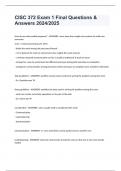Exam (elaborations)
CISC 372 Exam 1 Final Questions & Answers 2024/2025
- Course
- Institution
CISC 372 Exam 1 Final Questions & Answers 2024/2025 How do we write parallel programs? - ANSWERS- move away from single-core systems to multi-core processes (core = central processing unit, CPU) - divide the work among the processes/threads -- try to balance the work so each process has ro...
[Show more]



